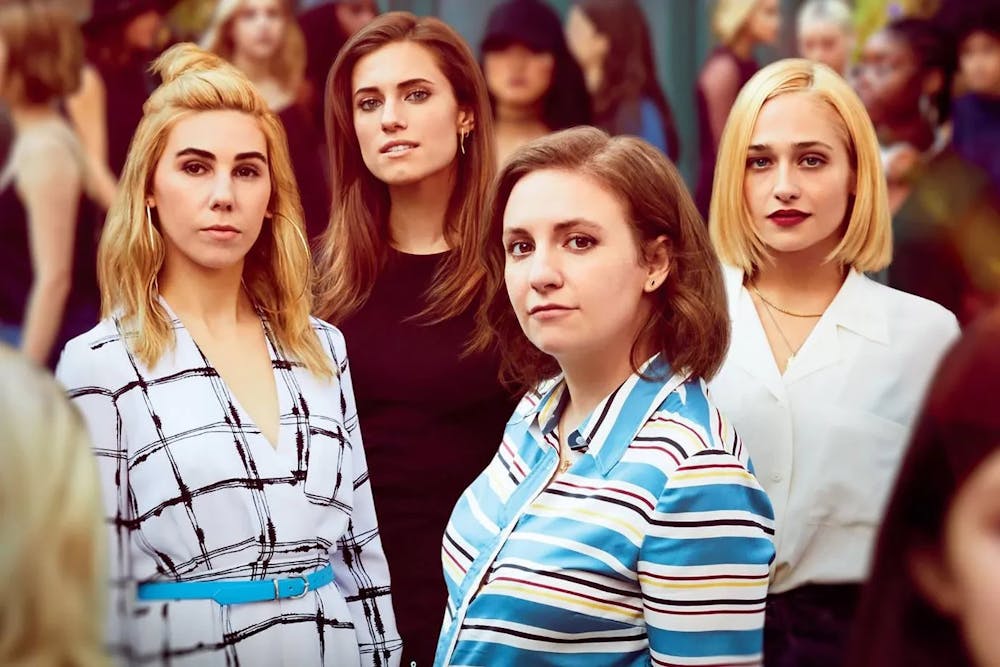HBO’s “Girls” is like a millennial time capsule. The strange combination of boho-chic and business casual outfits, the ubiquitousness of hipster culture and the scenic backdrop of gentrified Brooklyn brand the series with a mid-2010s stamp.
While the show's cultural landmarks are firmly millennial, many viewers have argued that the themes of navigating life as post-grad women are timeless. The show’s grittiness resonated with many viewers who were tired of watching picture-perfect portrayals of female foursomes in popular shows like “Sex and The City.”
When this show was recommended to me, I heard it was an accurate representation of post-grad life. Released by Lena Dunham in 2012 and lasting six seasons, the show follows four women: Hannah, the main character and unmotivated writer (played by Dunham); Marnie (Allison Williams), the neurotic but responsible art gallery receptionist; Jessa (Jenima Kirke), the effervescent and unemployed cool girl; and Shoshanna (Zosia Mamet), Jessa’s anxious younger cousin who attends NYU.
Hannah, Marnie and Jessa are friends from Oberlin College who moved to NYC, where they added Shoshanna to their group, about two years before the show began. The show strives to present a realistic depiction of the lives of young women in their twenties with toxic situationships, STI scares, unglamorous jobs and friend drama.
Despite the characters’ rocky friendships, the show weaves them back together in different storylines, but it does this seemingly against the girls’ wills. Essentially, beyond the first two seasons,the girls are not friends. This dynamic is a false depiction of female friendship. Sisterhood is so much more meaningful than what “Girls” portrays.
The show begins with Hannah and Marnie as roommates, presented as the core duo throughout the show because Jessa is off trapezing across New York and Shoshanna is a newer addition to the friend group. However, by the finale of Season 1, Marnie moves out after they argue about Hannah being selfish, and their friendship is never the same.
As each of the main characters develop throughout the series, they latch onto and have deep friendships with the men in their lives — rather than with each other. The most accurate portrayals of true friendship, even though they contained some romantic involvement, were the four main pairings: Shoshana and Ray, Marnie and Ray, Hannah and Elijah and Jessa and Adam.
The girls began to prioritize the men in their lives over each other. Hannah moves in with Elijah instead of patching up things with Marnie, Jessa starts dating Adam (Hannah’s ex) after Hannah leaves for grad school and Marnie hooks up with Ray immediately after he breaks up with Shoshanna. The girls were not neutrally drifting, they were actively being bad friends by repeatedly breaking girl code for the mediocre guys in their circle.
The state of their friendship is most evident to me during Season 3’s episode “Beach House”, where the girls go on a Marnie-planned getaway in North Fork to bring the gang back together.
Marnie announces to the girls, “We’re so disconnected now, I thought this would be a nice opportunity for us to have fun together, and, you know, prove to everyone via Instagram that we can still have fun as a group.”
However, the girls get in a blow-out fight at the end of the episode because the weekend inevitably turns south after Hannah invites Elijah and all of his guy friends to the girls weekend.
Shoshana gets the last word and iconically declares, “Sometimes I wonder if my social anxiety is holding me back from meeting the people who would actually be right for me instead of a bunch of f*cking whiny nothings as friends.”
Some hope for a redemption arc for the friend group after this episode, but that never happens. Each of the characters develop their own side plots with very limited crossover. The girls are not friends, and this is evident when Hannah doesn’t receive an invite to Shoshana’s engagement party in Season 6. Ouch.
“Girls” was innovative for its honest take on the dating lives and career success of post-grad women. But, its cynical view on female friendship is not one viewers should believe is the whole truth. For the majority of the show, the girls are not friends. When they “were,” they repeatedly break girl code.
Yes, friends separate or grow apart. But the show maintaining the facade of best friendship, when the characters find each other unbearable, is not an accurate model of female friendship. For women, friendships are some of our deepest relationships, those bonds are closer than family. Another TV show needs to portray the same honesty as “Girls” to that aspect of life.
Get The Chronicle straight to your inbox
Sign up for our weekly newsletter. Cancel at any time.
Olivia Prusky is a Trinity sophomore and a social media editor for Recess.

